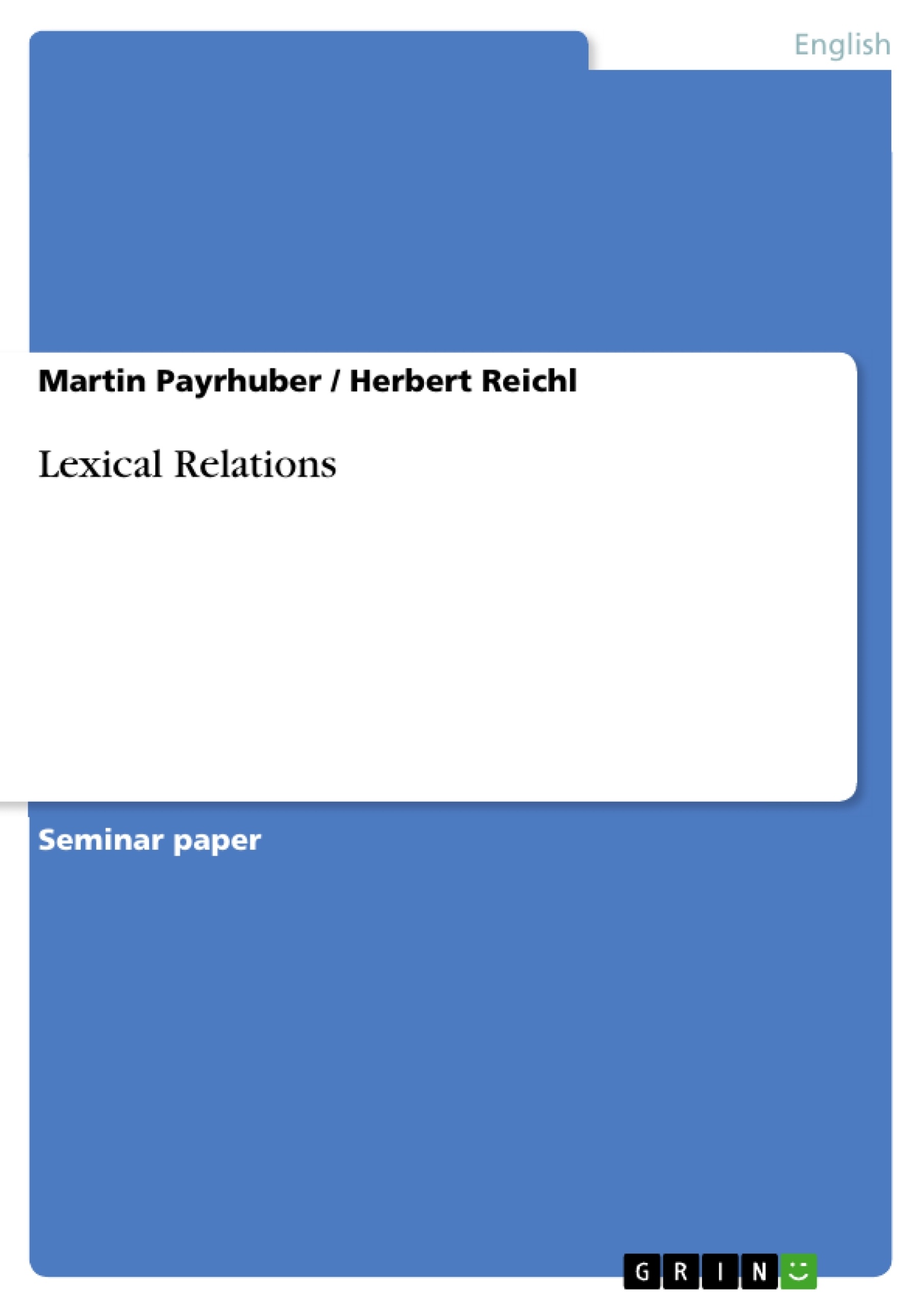There is no doubt, also - and especially - among experts, that our mental vocabulary is highly organised. There are a lot of relations between the single words of a language and the meanings of these words, respectively. Among linguists, these relations are called “semantic relations”, “sense relations” or “lexical relations”. These semantic relations can be analysed and described for the most part, and in the following, the most important ones of these relations are to be presented.
In order to give a short, critical description of the state of the art, it must be said that there are lots of research projects on this topic. However, this paper can only include some of them. Literature which was used can be found under point six, “List Of Works Cited”. Project delimitations have only been made as far as detail is concerned. Since this paper is only a very short piece of research, the authors have confined themselves not to go into too much detail, but rather try to give a good survey of the topic.
Table of Contents
- Introduction
- Types Of Ambiguity
- Polysemy And Homonymy
- “Relatedness” As Seen By Historic Semantics
- “Relatedness” As Seen By Synchronic Semantics
- Psychological Relatedness
- Types Of Congruence
- Synonymy
- Types Of Congruence
- Synonymy
- Meronymy
- Relations Of Contrast
- Opposition
- Antonymy
- Complementarity
- Converseness
- Incompatibility
- Scales
- Ranks
- Opposition
- Lexical Fields
- Conclusion
- List Of Works Cited
Objectives and Key Themes
This paper aims to provide a comprehensive overview of lexical relations in the English language. It examines the different types of ambiguity and congruence found in lexical items, exploring the complexities of semantic relationships within the vocabulary.
- The nature and types of lexical ambiguity (polysemy and homonymy).
- The concept of "relatedness" in lexical relations and its interpretation by historic and synchronic semantics.
- The different types of congruence, including synonymy, hyponymy, meronymy, and relations of contrast.
- The organization of lexical items into lexical fields.
- The importance of understanding lexical relations for the analysis and description of language.
Chapter Summaries
- Introduction: The paper sets the stage by introducing the concept of lexical relations as an essential aspect of language organization. It highlights the significance of studying these relations and outlines the major areas covered in the paper.
- Types Of Ambiguity: This chapter delves into the different types of ambiguity, focusing on polysemy and homonymy. It explores the challenges in distinguishing between these two phenomena and introduces the concept of "relatedness" as a key factor in their differentiation.
- "Relatedness" As Seen By Historic Semantics: This section examines the historical perspective on "relatedness," emphasizing the role of etymological roots in determining whether two meanings of a lexeme are considered polysemy or homonymy.
- "Relatedness" As Seen By Synchronic Semantics: This chapter presents the synchronic approach to "relatedness," focusing on the cognitive connection between meanings for a competent speaker of the language. It discusses how meanings with the same etymological origins can be considered homonymous if there is no natural connection between them.
- Psychological Relatedness: This section explores the notion of "psychological relatedness" as an alternative criterion for identifying polysemy and homonymy. It proposes that the ability of a language user to postulate a connection between meanings plays a significant role in determining their relatedness.
- Types Of Congruence: This chapter introduces the concept of congruence, focusing on synonymy as a type of lexical relationship. It lays the groundwork for further exploration of other types of congruence in subsequent chapters.
- Types Of Congruence: This chapter continues the discussion of congruence, examining meronymy and relations of contrast. It elaborates on different types of opposition and incompatibility within the framework of lexical relations.
- Lexical Fields: This chapter focuses on the organization of lexical items into lexical fields, exploring the concept of semantic fields and their implications for understanding vocabulary structure.
Keywords
Key terms and concepts explored in this paper include lexical relations, semantic relations, sense relations, polysemy, homonymy, relatedness, historic semantics, synchronic semantics, psychological relatedness, congruence, synonymy, hyponymy, meronymy, relations of contrast, opposition, antonymy, complementarity, converseness, incompatibility, scales, ranks, and lexical fields.
- Citation du texte
- Martin Payrhuber (Auteur), Herbert Reichl (Auteur), 1999, Lexical Relations, Munich, GRIN Verlag, https://www.grin.com/document/54837



